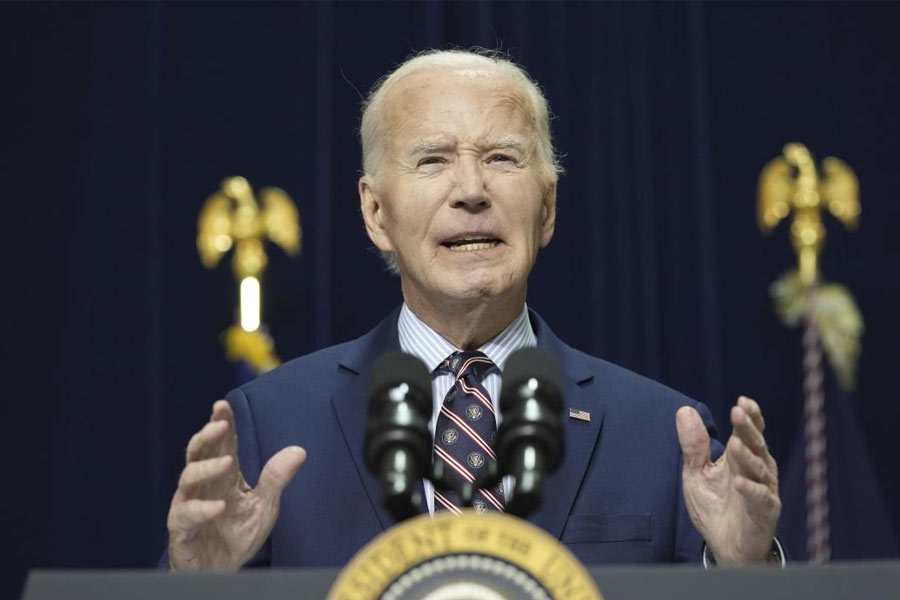 Saturday, 04 January 2025
Saturday, 04 January 2025
 Saturday, 04 January 2025
Saturday, 04 January 2025
Five-trillion-dollar economy: The shifting deadline
Speaking at the BRICS summit held in South Africa in August 2023, Prime Minister Narendra Modi had said the global economic turmoil had had no impact on the Indian economy.
“Soon, India will become a $5 trillion economy. There is no doubt that India will be the growth engine of the world in the years to come,” Modi had said at the meet.
Nine months before Modi’s comments, Union home minister Amit Shah had set a deadline for end-2025 to achieve the target.
Days before the summit, addressing the nation from the ramparts of the Red Fort during the annual Independence day speech, Modi had said: “It is important to know about this because there are some people who doubt the capabilities of Indians. They are saying it is very difficult to achieve this goal. However, it would be a matter of courage, of new possibility, of the sacrificial fire of development, of serving Maa Bharati, and dreaming of New India. These dreams are largely linked to the goal of $5 trillion economy.”
The former President Ramnath Kovind had on September 10, 2019 posted on ‘X’ (formerly Twitter): “India has set a target to become a five trillion dollar economy by 2025.”
In December 2022, external affairs minister S. Jaishankar had set the deadline to achieve a $5 trillion dollar economy by 2025, while Amit Shah at an event in Chennai in November 2022 had declared end-2025 as the deadline.
Going by Shah’s words, India still has 364 days to reach the goal.
Indian roads were to match US standards by end 2024
Nitin Gadkari, Union minister for road transport and highways, has often reiterated the promise from every platform made available to him including the hallowed precincts of the Indian Parliament.
“I have often said our prosperity is linked to our roads. Since I have started working in this field I keep in mind what John Kennedy (the former US President) had said. ‘American roads are not good because America is rich. But America is rich because American roads are good.’ To make India self-reliant, a happy, powerful, prosperous, a pledge that Modi has taken, on the basis of that I want to assure the House before 2024 ends, India’s road infrastructure will match those of the US,” Gadkari had said during his reply to the Budget proposals for his ministry in the 2022-23 fiscal year.
Since then Gadkari has often repeated the promise, yet somehow the deadline got missed.
A fresh deadline has not been announced yet, though the Internet had a field day poking the minister.
Zero food children: When will they become zero?
The target was to make India free of malnutrition by the year 2022. That was about three years ago.
In February 2024, a study by Harvard TH Chan School of Public Health published a study that put India at the top of the list of “zero-food” children, those between six months to less than two years old who did not consume any milk, formula, or food in the last 24 hours.
India with 6.7million children ranked above Nigeria, Pakistan, Ethiopia, the Democratic Republic of Congo, Egypt, Bangladesh, Mali, Sudan and Angola.
The findings published in the journal of the American Medical Association’s open network were denied by India’s ministry of women and child development as a “deliberate and malicious attempt by interested lobbies to sensationalise fake news”.
Five months later, Annapurna Devi, Union minister for women and child development, in response to a question in the Lok Sabha said that of the 8.57 crore children below the age of six, 17 per cent were underweight, 36 per cent stunted and 6 per cent wasted, all indications of malnutrition.
Manual scavenging to be eradicated
Visiting the Kumbh Mela in February 2019 in Allahabad, Modi had washed the feet of five manual scavengers, including two women, and expressed his gratitude towards them for keeping the holy congregation clean.
More than a year later, in November 2020, the Union government announced several measures to eradicate the practice of manual scavenging by August 2021. Four years later, little has been heard about the promise, though the steps to eradicate the practice date back to 30 years ago.
Between 2024 February and July before and after the last Lok Sabha polls, 43 manual scavengers had died.
In 2023, the Narendra Modi government had allocated Rs 97 crore under the National Action for Mechanised Sanitation Ecosystem (NAMASTE) scheme, which was later reduced to Rs 30 crore.
For the current fiscal year, the funds allocated were around Rs 117 crore. How much has actually been spent will be known only when the next Budget is placed.
Meanwhile, manual scavenging continues while India heads towards being a $5 trillion economy.
Two crore jobs every year
More than a decade ago, Narendra Modi came to power promising jobs to India’s youth. Into his third term now, the unemployment rate in the country in September 2024 (according to data released by the independent think tank Centre for Monitoring Indian Economy) stood at 7.8 per cent, higher than what it was a decade ago when Modi was into his first term as prime minister.
The unemployment rate in 2014 was 5.44 per cent, marginally higher than what it was in the last year of the UPA-II.
The India Employment Report 2024 prepared by the International Labour Organisation and the Institute for Human Development had stated the number of educated youth among all jobless people in the country had jumped to 65.7 per cent in 2022 from the preceding 54.2 per cent.
Unveiling the BJP manifesto ahead of the 2024 Lok Sabha polls, Modi had said at the BJP headquarters, “India’s youth will not have even imagined the number of opportunities that will come their way.”
Still awaited.







